Reading trade books is an important component of an interdisciplinary approach to developing literacy skills and learning STEM content. This week’s column includes books that are effective choices for introducing lessons and activities on STEM topics as well as for independent reading in the disciplines of science, technology, engineering, and mathematics.
Ages 4–8
Bloom Boom! April Pulley Sayres. 2019. Beach Lane/Simon & Schuster.
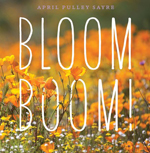 “Every spring, / across the land.... /Seeds sprout. / Stems pop out. / Bloom, / boom!” With lyrical text and stunning photographs, author and photo-illustrator April Pulley Sayres celebrates the profusion of flowers that burst out all at once in the spring in glorious bloom booms. Back matter includes information on the spring blooms in various regions (desert, meadows, woodlands, gardens, forests, and hills); “A Bit More About the Blooms” section with the common and scientific names and notes about the plants featured; and a list of resources.
“Every spring, / across the land.... /Seeds sprout. / Stems pop out. / Bloom, / boom!” With lyrical text and stunning photographs, author and photo-illustrator April Pulley Sayres celebrates the profusion of flowers that burst out all at once in the spring in glorious bloom booms. Back matter includes information on the spring blooms in various regions (desert, meadows, woodlands, gardens, forests, and hills); “A Bit More About the Blooms” section with the common and scientific names and notes about the plants featured; and a list of resources.
—CA
Flower Talk: How Plants Use Color to Communicate. Sarah C. Levine. Ill. Masha D’yans. 2019. Millbrook/Lerner.
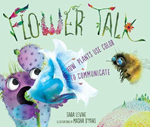 In this book, a cranky cactus describes why the color of a plant’s flowers is important for attracting the appropriate pollinators. For example, plants with red flowers are typically visited only by birds, while plants with blue or purple flowers are usually visited by bees. Vibrant watercolor paintings add to the humor of this engaging informational picture book about “flower talk.” Back matter includes a more detailed explanation about pollination, some tips on how to protect animals that are pollinators, and a list of other books about plants and pollinators for young readers.
In this book, a cranky cactus describes why the color of a plant’s flowers is important for attracting the appropriate pollinators. For example, plants with red flowers are typically visited only by birds, while plants with blue or purple flowers are usually visited by bees. Vibrant watercolor paintings add to the humor of this engaging informational picture book about “flower talk.” Back matter includes a more detailed explanation about pollination, some tips on how to protect animals that are pollinators, and a list of other books about plants and pollinators for young readers.
—JS
The Frog Book. Steve Jenkins & Robin Page. Ill. Steve Jenkins. 2019. Houghton Mifflin.
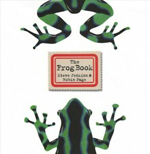 In their latest collaboration, Steve Jenkins and Robin Page introduce readers to some of the more than 6,000 species of frogs, amphibians that live both in the water and on land and are found on every continent except Antarctica. Double-page spreads feature images of frogs, created in Jenkins’ signature cut- and torn-paper collage technique, and accessible text on characteristics (body structure, metamorphosis, and behavior); the diversity of frogs in colors, shapes, sizes; habitats; special adaptations; “extreme frogs,” record holders in the world of frog; and conservation status (one-third of all frog species are in danger of extinction). Back matter includes a table showing the sizes, diets, and ranges of the frogs in the book, and a list of books and websites for more information.
In their latest collaboration, Steve Jenkins and Robin Page introduce readers to some of the more than 6,000 species of frogs, amphibians that live both in the water and on land and are found on every continent except Antarctica. Double-page spreads feature images of frogs, created in Jenkins’ signature cut- and torn-paper collage technique, and accessible text on characteristics (body structure, metamorphosis, and behavior); the diversity of frogs in colors, shapes, sizes; habitats; special adaptations; “extreme frogs,” record holders in the world of frog; and conservation status (one-third of all frog species are in danger of extinction). Back matter includes a table showing the sizes, diets, and ranges of the frogs in the book, and a list of books and websites for more information.
—CA
The Night Flower. Lara Hathorne. 2019. Big Picture/Candlewick.
 With a descriptive text of rhyming quatrains and expressive stylized illustrations, Lara Hawthorne presents a story of the activity in the Sonoran Desert over 24 hours that ends with the dramatic once-a-year nighttime blooming of the Saguaro cactus. The strong scent and brilliant white petals of the magnificent flowers of the Saguaro attracts the cactus’ pollinators, brown bats with black wings. Back matter includes diagrams of the life cycle and structure of the Saguaro, a “Did you spot...?” section of fauna (including the long-nosed bat and white-lined sphinx moth, nocturnal visitors to the Saguaro flowers) in the illustration, and a glossary.
With a descriptive text of rhyming quatrains and expressive stylized illustrations, Lara Hawthorne presents a story of the activity in the Sonoran Desert over 24 hours that ends with the dramatic once-a-year nighttime blooming of the Saguaro cactus. The strong scent and brilliant white petals of the magnificent flowers of the Saguaro attracts the cactus’ pollinators, brown bats with black wings. Back matter includes diagrams of the life cycle and structure of the Saguaro, a “Did you spot...?” section of fauna (including the long-nosed bat and white-lined sphinx moth, nocturnal visitors to the Saguaro flowers) in the illustration, and a glossary.
—CA
Seashells: More Than A Home. Melissa Stewart. Ill. Sarah S. Brannen. 2019. Charlesbridge.
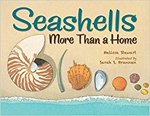 Young children, especially those who have collected seashells at the beach, will enjoy the informative text and realistic watercolor illustrations of this informational book that features 13 different types of shells and how they are used. For example, the flat, round bivalve shell of a scallop is used to propel the mollusk through the water and to protect it from predators when closed. A nature journal feature for each shell gives young naturalists a glimpse into how they might document their own sand treasures. Back matter includes a double-page spread identifying the five major groups of mollusks: bivalves, cephalopods, chitons, gastropods, and scaphopods; author’s and illustrator’s notes; suggested books for young readers; and selected sources used by the author and the illustrator. The endpapers provide information about the habitats and ranges of the 13 featured mollusks.
Young children, especially those who have collected seashells at the beach, will enjoy the informative text and realistic watercolor illustrations of this informational book that features 13 different types of shells and how they are used. For example, the flat, round bivalve shell of a scallop is used to propel the mollusk through the water and to protect it from predators when closed. A nature journal feature for each shell gives young naturalists a glimpse into how they might document their own sand treasures. Back matter includes a double-page spread identifying the five major groups of mollusks: bivalves, cephalopods, chitons, gastropods, and scaphopods; author’s and illustrator’s notes; suggested books for young readers; and selected sources used by the author and the illustrator. The endpapers provide information about the habitats and ranges of the 13 featured mollusks.
—JS
Skyscraper. Jorey Hurley. 2019. Paula Wiseman/Simon & Schuster.
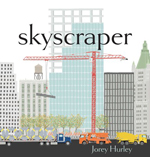 This nearly wordless picture book features a single verb (such as “crush,” “scoop,” “dig,” or “push”) on each double-page spread alongside an image of the construction vehicle that performs that job in the building of a skyscraper. The colorful illustrations created in Photoshop will captivate young children who love construction trucks of all kinds. A two-page glossary presents images and names of the 14 construction vehicles featured in the book and brief descriptions of their special job. For example, “A front loader lifts and relocates batches of loose materials such as demolition debris.”
This nearly wordless picture book features a single verb (such as “crush,” “scoop,” “dig,” or “push”) on each double-page spread alongside an image of the construction vehicle that performs that job in the building of a skyscraper. The colorful illustrations created in Photoshop will captivate young children who love construction trucks of all kinds. A two-page glossary presents images and names of the 14 construction vehicles featured in the book and brief descriptions of their special job. For example, “A front loader lifts and relocates batches of loose materials such as demolition debris.”
—JS
Soar High, Dragonfly! Sheri Mabry Bestor. Ill. Jonny Lambert. 2019. Sleeping Bear.
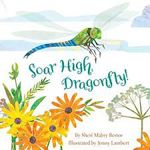 The life cycle of the green darner dragonfly is presented with a lyrical primary text and brightly colored, stylized illustrations with the look of collage artwork. Each double-page spread also includes a block of text in a smaller font that provides additional information about dragonflies and details of their incomplete metamorphosis: egg, nymph, and adult. Pair this inviting picture book with Bestor and Lambert’s Good Trick, Walking Stick! (2016) to introduce lessons on the life cycles of insects to young children.
The life cycle of the green darner dragonfly is presented with a lyrical primary text and brightly colored, stylized illustrations with the look of collage artwork. Each double-page spread also includes a block of text in a smaller font that provides additional information about dragonflies and details of their incomplete metamorphosis: egg, nymph, and adult. Pair this inviting picture book with Bestor and Lambert’s Good Trick, Walking Stick! (2016) to introduce lessons on the life cycles of insects to young children.
—CA
Ages 9–11
The Everyday Journeys of Ordinary Things: From Phones to Food and from Paper to Poo…The Way the World Works. Libby Deutsch. Ill. Valpuri Kerttula. 2019. Kane Miller.
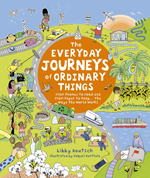 “Every day we are surrounded by ordinary objects and services that have been on the most extraordinary journeys to reach us,” and this child-friendly oversize book describes some of these journeys through step-by-step diagrams with illustrations and brief text. Red arrows direct the reader in following numbered steps that meander across each double-page spread. Curious young children will enjoy following the steps of 20 examples from the journey made by a birthday card in “How Does Mail Reach Me?” to how milk gets to your breakfast table in “From Cow to Carton.”
“Every day we are surrounded by ordinary objects and services that have been on the most extraordinary journeys to reach us,” and this child-friendly oversize book describes some of these journeys through step-by-step diagrams with illustrations and brief text. Red arrows direct the reader in following numbered steps that meander across each double-page spread. Curious young children will enjoy following the steps of 20 examples from the journey made by a birthday card in “How Does Mail Reach Me?” to how milk gets to your breakfast table in “From Cow to Carton.”
—CA
Just Right: Searching for the Goldilocks Planet. Curtis Manley. Ill. Jessica Lanan. 2019. Roaring Brook/Macmillan.
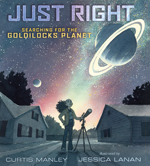 A curious young girl wonders whether any of the stars she sees in the night sky have planets orbiting around them and whether there is life on them. Readers join her on a visit to a planetarium’s “Searching for Exoplanets Exhibition” to learn how astronomers use powerful telescopes to search for a planet much like Earth, a Goldilocks planet “just right” for supporting life. So far scientists have found no proof of life elsewhere, but they continue to search for it. The last part of this informational picture book explores the question of what that life might be like. “Maybe it’s beings like ourselves...Or maybe it’s like nothing we can even imagine.” The endpapers feature a timeline of discoveries of our place in the universe. Back matter includes additional information on the science of detecting exoplanets, a bibliography, and sources for information.
A curious young girl wonders whether any of the stars she sees in the night sky have planets orbiting around them and whether there is life on them. Readers join her on a visit to a planetarium’s “Searching for Exoplanets Exhibition” to learn how astronomers use powerful telescopes to search for a planet much like Earth, a Goldilocks planet “just right” for supporting life. So far scientists have found no proof of life elsewhere, but they continue to search for it. The last part of this informational picture book explores the question of what that life might be like. “Maybe it’s beings like ourselves...Or maybe it’s like nothing we can even imagine.” The endpapers feature a timeline of discoveries of our place in the universe. Back matter includes additional information on the science of detecting exoplanets, a bibliography, and sources for information.
—CA
Rotten!: Vultures, Beetles, Slime, and Nature’s Other Decomposers. Anita Sanchez. Ill. Gilbert Ford. 2019. Houghton Mifflin.
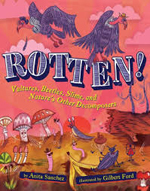 “It’s a rotten world” and that’s not a bad thing. Anita Sanchez explores the fascinating process of decomposition in eight accessible chapters that take the reader on “a trip into the world of rotten” that introduces different decomposers from dung beetles to earthworms to vultures. An inviting format features “decomposer selfies”; the answers to questions such as “Why do dung beetles love dung?” and “Why does a dead animal smell so bad?”; “Rot It Yourself” activities such as building a compost pile; and colorful cartoon artwork that complements the lighthearted tone of the text. Back matter includes a glossary, sources of quotes, an extensive bibliography, and an index.
“It’s a rotten world” and that’s not a bad thing. Anita Sanchez explores the fascinating process of decomposition in eight accessible chapters that take the reader on “a trip into the world of rotten” that introduces different decomposers from dung beetles to earthworms to vultures. An inviting format features “decomposer selfies”; the answers to questions such as “Why do dung beetles love dung?” and “Why does a dead animal smell so bad?”; “Rot It Yourself” activities such as building a compost pile; and colorful cartoon artwork that complements the lighthearted tone of the text. Back matter includes a glossary, sources of quotes, an extensive bibliography, and an index.
—JS
Ages 12–14
A Ray of Light: A Book of Science and Wonder. Walter Wick. 2019. Scholastic.
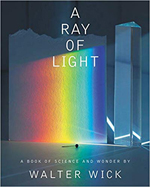 “What about light? What is it made of? How does it fit alongside everything else in the world? With these questions, author and photographer Walter Wick introduces this fascinating exploration of the science of light. Each spread features striking color photographs and paragraphs of text which serve as extended captions of the photographs on a specific principle such as incandescence, light waves, the color spectrum, and iridescence. Two pages of notes on the science and experiments Wick presents in this stunning visual presentation on light provide additional details that will be of interest to more advanced readers and those using this book in STEM programs.
“What about light? What is it made of? How does it fit alongside everything else in the world? With these questions, author and photographer Walter Wick introduces this fascinating exploration of the science of light. Each spread features striking color photographs and paragraphs of text which serve as extended captions of the photographs on a specific principle such as incandescence, light waves, the color spectrum, and iridescence. Two pages of notes on the science and experiments Wick presents in this stunning visual presentation on light provide additional details that will be of interest to more advanced readers and those using this book in STEM programs.
—CA
The Woolly Monkey Mysteries: The Quest to Save a Rain Forest Species. Sandra Markle. 2019. Millbrook/Lerner.
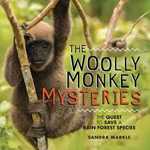 For years, not much has been known about the species of woolly monkeys found in the rain forests of South America, but a recent project involving the installation of over 30 camera traps (a tool used by scientists to capture and record photographs of wild animals) has allowed researchers to understand more about the behavior of this primate species. Sandra Markle’s accessible text, with captioned photographs and diagrams, provides readers with information on how scientists are working to learn more about the complexities of survival of the woolly monkey in the wild. QR codes throughout the book allow readers to access related video and sound-bytes. Back matter includes an author’s note, glossary, a “Find Out More” section with text and web-based resources, and an index.
For years, not much has been known about the species of woolly monkeys found in the rain forests of South America, but a recent project involving the installation of over 30 camera traps (a tool used by scientists to capture and record photographs of wild animals) has allowed researchers to understand more about the behavior of this primate species. Sandra Markle’s accessible text, with captioned photographs and diagrams, provides readers with information on how scientists are working to learn more about the complexities of survival of the woolly monkey in the wild. QR codes throughout the book allow readers to access related video and sound-bytes. Back matter includes an author’s note, glossary, a “Find Out More” section with text and web-based resources, and an index.
—JS
Ages 15+
The Electric War: Edison, Tesla, Westinghouse, and the Race to Light the World. Mike Winchell. 2019. Christy Ottaviano/Henry Holt/Macmillan.
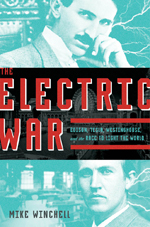 During the Gilded Age, a time when innovation became big business, a battle ensued over who would win “the race to light the world.” The competitors were Thomas Alva Edison (1847–1931), inventor of the established direct current system of electricity, and Nikola Tesla (1856–1943) and George Westinghouse (1846–1914), with their experimental alternating current system. The inviting conversational tone of Mike Winchell’s well-researched narrative, complemented by captioned black-and-white photographs and diagrams, provides an accessible account of this important scientific competition. Back matter includes a timeline, an extensive bibliography, and an index.
During the Gilded Age, a time when innovation became big business, a battle ensued over who would win “the race to light the world.” The competitors were Thomas Alva Edison (1847–1931), inventor of the established direct current system of electricity, and Nikola Tesla (1856–1943) and George Westinghouse (1846–1914), with their experimental alternating current system. The inviting conversational tone of Mike Winchell’s well-researched narrative, complemented by captioned black-and-white photographs and diagrams, provides an accessible account of this important scientific competition. Back matter includes a timeline, an extensive bibliography, and an index.
—CA
Jennifer W. Shettel is a professor at Millersville University of Pennsylvania where she teaches undergraduate and graduate courses in literacy for preservice and practicing teachers. Prior to joining the faculty at Millersville, she spent 16 years as an elementary classroom teacher and reading specialist in the public schools. Carolyn Angus is former director of the George G. Stone Center for Children's Books, Claremont Graduate University, in Claremont, California.
These reviews are submitted by members of the International Literacy Association's Children's Literature and Reading Special Interest Group (CL/R SIG) and are published weekly on Literacy Daily.